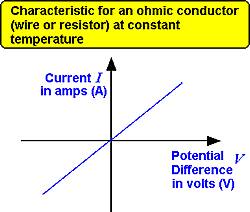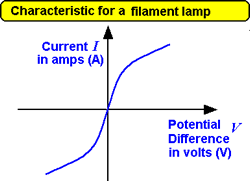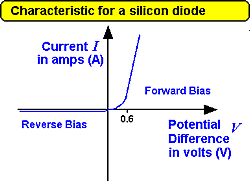You should be able to explain that, for some resistors, the value of R remains constant but that in others it can change as the current changes.

The current through an ohmic conductor (at a constant temperature) is directly proportional to the potential difference across the resistor.

This means that the resistance remains constant as the current changes.

The resistance of components such as lamps, diodes, thermistors and LDRs is not constant; it changes with the current through the component.

The resistance of a filament lamp increases as the temperature of the filament increases.


The current through a diode flows in one direction only. The diode has a very high resistance in the reverse direction.


The resistance of a thermistor decreases as the temperature increases.
The applications of thermistors in circuits eg a thermostat is required.

The resistance of an LDR decreases as light intensity increases.
The application of LDRs in circuits eg switching lights on when it gets dark is required.
You should be able to:
 explain the design and use of a circuit to measure the resistance of a component by measuring the current through, and potential difference across, the component explain the design and use of a circuit to measure the resistance of a component by measuring the current through, and potential difference across, the component
 draw an appropriate circuit diagram using correct circuit symbols. draw an appropriate circuit diagram using correct circuit symbols.
 Investigate the relationship between the resistance of a thermistor and temperature. Investigate the relationship between the resistance of a thermistor and temperature.
 Investigate the relationship between the resistance of an LDR and light intensity. Investigate the relationship between the resistance of an LDR and light intensity.
 use graphs to explore whether circuit elements are linear or non-linear and relate the curves produced to their function and properties. use graphs to explore whether circuit elements are linear or non-linear and relate the curves produced to their function and properties.
Required practical activity 4:

Use circuit diagrams to construct appropriate circuits to investigate the I–V characteristics of a variety of circuit elements, including a filament lamp, a diode and a resistor at constant temperature.
|
|


